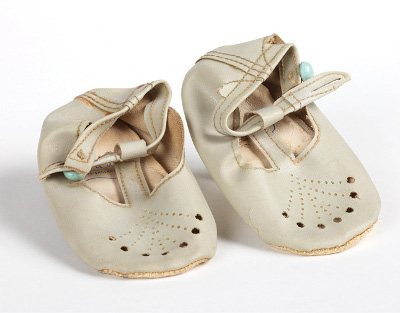This article is taken from PN Review 252, Volume 46 Number 4, March - April 2020.
Pictures from the Rylands Library
49. Worn Worlds: The Poetry of Adam Johnson’s Baby Shoes
Baby Shoes: Not for Sale. Worn Many Times. The original blue of their early 1960s hue has faded to grey and ‘the constancy of [a] human presence permeates every surface’ (Neruda). Shoes, as Derrida observes, ‘both shape and are shaped by the body; they take in oils and the smells of the body’ and yet shoes ‘have a life of their own; they are material presences and they encode other material and immaterial presences… and can transform identities’ (Peter Stallybrass). Through use, clothing becomes ‘singularised [and] bears the stamp of the individuality and everyday experience of its owner’ (Sheila Harpur). In receiving the imprint of a human being, albeit at an embryonic stage in its life cycle (as in the case here), we see how a mass produced commodity can be transformed into vibrant matter, and radiate ‘a magnetism that should not be scorned [for] this is the poetry we are seeking’ (Neruda).

Neruda’s ‘poetry of the worn and permeated surface’ was not a subject lost on Adam Johnson, one of the most promising poets of his generation, who became the author of a series of critically acclaimed collections of poetry, including: Poems (1992), The Spiral Staircase (1993), The Playground Bell (1994) and Collected Poems (2003). Reputedly a snappy dresser, he often favoured ‘white suits and bow ties he never learnt to tie’, as shown in the photo here. His ‘high-cheeked, matinée-idol good looks were well known on the poetry circuit’ (Hugh David). He ...

Neruda’s ‘poetry of the worn and permeated surface’ was not a subject lost on Adam Johnson, one of the most promising poets of his generation, who became the author of a series of critically acclaimed collections of poetry, including: Poems (1992), The Spiral Staircase (1993), The Playground Bell (1994) and Collected Poems (2003). Reputedly a snappy dresser, he often favoured ‘white suits and bow ties he never learnt to tie’, as shown in the photo here. His ‘high-cheeked, matinée-idol good looks were well known on the poetry circuit’ (Hugh David). He ...
The page you have requested is restricted to subscribers only. Please enter your username and password and click on 'Continue':
If you have forgotten your username and password, please enter the email address you used when you joined. Your login details will then be emailed to the address specified.
If you are not a subscriber and would like to enjoy the 292 issues containing over 11,700 poems, articles, reports, interviews and reviews,
why not subscribe to the website today?
